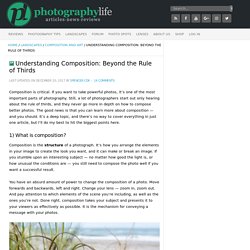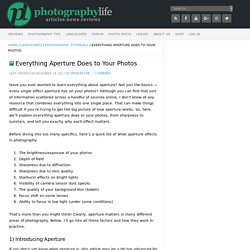

Aperture - Photography Basics. Aperture is one of the three pillars of photography, with the other two being ISO and Shutter Speed.

It might be the single most important camera setting in all of photography, simply because it affects so many different variables of an image. Aperture can add dimension to your photographs by blurring the background, and it also alters the exposure of your images by making them brighter or darker. In this article, we will cover everything you need to know about aperture, all in very simple language. 1) What is Aperture? Simply put, aperture is a hole within a lens, through which light travels into the camera body. Understanding Composition: Beyond the Rule of Thirds.
Composition is critical.

If you want to take powerful photos, it’s one of the most important parts of photography. Still, a lot of photographers start out only hearing about the rule of thirds, and they never go more in depth on how to compose better photos. The good news is that you can learn more about composition — and you should. It’s a deep topic, and there’s no way to cover everything in just one article, but I’ll do my best to hit the biggest points here. Everything Aperture Does to Your Photos. Have you ever wanted to learn everything about aperture?

Not just the basics — every single effect aperture has on your photos? Although you can find that sort of information scattered across a handful of sources online, I don’t know of any resource that combines everything into one single place. That can make things difficult if you’re trying to get the big picture of how aperture works. So, here, we’ll explain everything aperture does to your photos, from sharpness to sunstars, and tell you exactly why each effect matters. DSLR Camera Metering Modes Explained. WHAT EACH FUNCTION OF THE CANON T2I OR 550D DOES AND HOW TO USE THEM PART 1. Shoot in Manual Mode Pt. 1 - Aperture, Shutter Speed and ISO explained. WHAT EACH FUNCTION OF THE CANON T2I OR 550D DOES AND HOW TO USE THEM PART 1. Understanding Exposure - ISO, Aperture and Shutter Speed Explained. What controls exposure?

ISO ratings determine the image sensor’s sensitivity to light, each value of the rating represents a “stop” of light, and each incremental ISO number (up or down) represents a doubling or halving of the sensor’s sensitivity to light. The Aperture controls the lens’ diaphragm, which controls the amount of light traveling through the lens to the film plane. The aperture setting is indicated by the f-number, whereas each f-number represents a “stop” of light. The Shutter Speed indicates the speed in which the curtain opens then closes, and each shutter speed value also represents a “stop” of light. The shutter speed is measured in fractions of a second. When these three elements are combined, they represent a given exposure value (EV) for a given setting.
ISO Speed ISO is actually an acronym, which stands for International Standards Organization. Photography Class 1. A Beginner's Guide to Photoshop Elements - Part 3 - Touring the Quick Fix & Guided Modes. Beginners guide to photoshop elements part 2 - Bing Vidéos. 3photoshop.com. Corel_RulesElementsofComp.pdf. 10 Tips to Get Started with Still Life Photography. There aren’t many photographic practices that date back further than still life photography.

When photography originated, it was necessary for exposures to be quite long, so photographing static objects was the ideal subject matter. However, as the technology developed, the fascination for capturing still life has remained and is still one of the most viable photographic professions today. At the top end, it is an extremely lucrative business, as magazines, catalogues and websites all require product shots. There are many advantages to working with still life that are often underestimated, so hopefully you’ll be able to see it’s scope for creativity and get started with taking some shots yourself! Contrary to common perceptions, you don’t need a studio or a fancy location to make a start with still life photography.
What is White Balance? Ever wondered why your subjects turn out yellow when photographing them in indoor environments?

Or why your camera flash can make them appear blue? Thoroughly understanding the concept of white balance and how it works is very important in digital photography, because setting it incorrectly could ruin a picture, adding all kinds of unwanted color casts and causing skin tones to look very unnatural. In this article, I will explain how you can adjust it on your camera or post-production to get accurate colors. 1) Definition of White Balance Simply put, white balance in digital photography means adjusting colors so that the image looks more natural.
If you are a skier or a snowboarder, try this quick experiment: put on your ski goggles and look at the snow – it should change in color tone. While our brains automatically process the colors for us in such a smart way, digital cameras can only guess what the color temperature is by watching the ambient light. 44 essential digital camera tips and tricks. Our collection of top digital camera tips and essential photography advice will have you improving your photos in no time.

Culled from experts and photographers who have been taking pictures for quite some time, they all agree that these 44 camera tips are essential knowledge for honing your craft. So feast your eyes below, check out some of our best photography tips on everything from setting up your digital camera to honing your photo composition, and by the end you will learn the secrets and shortcuts to getting high-quality pictures every time. Depth of Field and Lens effects. Depth of Field : Photography Tutorial for Beginners (Bokeh) - CamCrunch. Photography Tips for Beginners. Beginner Photography Tips - How to hold a camera when shooting in low light. Understanding Aperture - A Beginner's Guide. Aperture and Depth of Field. Depth of Field Depth of Field (DOF) is the front-to-back zone of a photograph in which the image is razor sharp.

As soon as an object (person, thing) falls out of this range, it begins to lose focus at an accelerating degree the farther out of the zone it falls; e.g. closer to the lens or deeper into the background. With any DOF zone, there is a Point of Optimum focus in which the object is most sharp. Cambridge in Colour - Photography Tutorials & Learning Community. Welcome to your Free Photography Course - suziemaus - Gmail. Camera Exposure: Aperture, ISO & Shutter Speed. A photograph's exposure determines how light or dark an image will appear when it's been captured by your camera.

Believe it or not, this is determined by just three camera settings: aperture, ISO and shutter speed (the "exposure triangle"). Mastering their use is an essential part of developing an intuition for photography. Achieving the correct exposure is a lot like collecting rain in a bucket. While the rate of rainfall is uncontrollable, three factors remain under your control: the bucket's width, the duration you leave it in the rain, and the quantity of rain you want to collect. You just need to ensure you don't collect too little ("underexposed"), but that you also don't collect too much ("overexposed").
In photography, the exposure settings of aperture, shutter speed and ISO speed are analogous to the width, time and quantity discussed above. Each setting controls exposure differently: By the Numbers. How it Appears. Slow Shutter Speed Fast Shutter Speed By the Numbers.